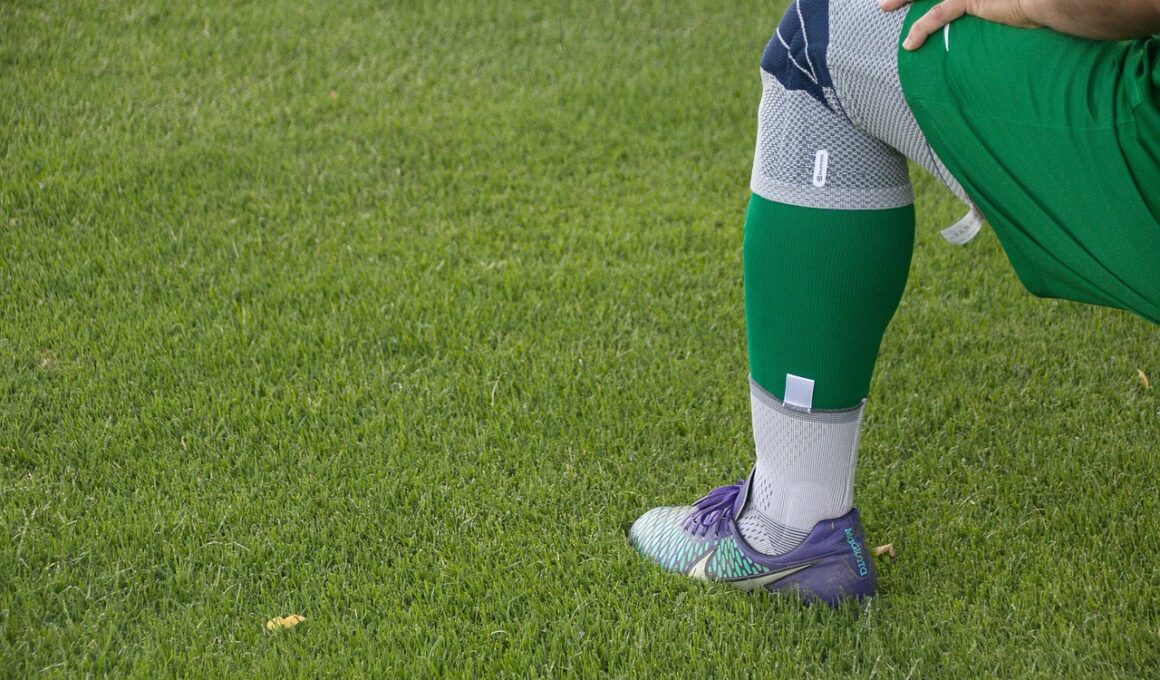Preventing Knee Injuries in Rowing: What You Need to Know
Rowing, while an exceptional full-body workout, can sometimes lead to knee injuries if proper techniques and preventive measures are not adhered to. The repetitive motion of rowing puts a significant strain on the knees, which can potentially cause discomfort or injury. Understanding the anatomy of the knee and its mechanics during rowing can help athletes recognize the importance of maintaining their knee health. Common injuries may stem from improper posture, overtraining, or incorrect equipment adjustments. It’s essential for rowers, whether novice or experienced, to remain vigilant about their physical condition and adhere to guidelines designed to keep them safe. Emphasizing micro-adjustments to rowing techniques can enhance performance while simultaneously minimizing injury risk. Furthermore, establishing a proper warm-up routine, including stretching exercises, can also play a critical role in injury prevention. Each rower should also consult with their coach or a sports therapist to ensure that their technique is sound and that they receive tailored advice based on their individual physical condition. Awareness and proactive steps are vital in protecting rowers from knee injuries.
Understanding Common Knee Injuries in Rowing
Several common knee injuries affect rowers, but being aware of these can help in prevention. Knee tendonitis, also known as “jumper’s knee,” is a prevalent concern, particularly among rowers who do not appropriately warm up or strengthen their leg muscles. This condition is typically caused by inflammation of the knee joint resulting from excessive stress or overuse. Patellofemoral pain syndrome, characterized by pain around the kneecap, is another common issue, often linked to muscle imbalances or improper squat mechanics. In order to effectively prevent these injuries, athletes should engage in targeted strength training focused on their hamstrings, quadriceps, and hip muscles. Additionally, working on flexibility through dynamic stretching regularly — specifically, the quadriceps and hamstrings — can mitigate the risk significantly. Another consideration is the type of footwear used during rowing sessions; supportive footwear can make a significant difference in how the ankle and knee work during repeated movements and can distribute forces evenly across the leg. Regular check-ins with coaches and trainers help identify early signs of tensions, which could lead to more serious injuries.
Effective warm-up routines are integral to preventing injuries, particularly regarding knee health in rowing. Athletes should dedicate at least 15-20 minutes before training sessions or races to a comprehensive warm-up routine. A well-structured warm-up should include both dynamic stretches and gradual increases in intensity, effectively preparing the muscles and joints for activity. Incorporating exercises that mimic rowing motions can help ensure that the muscles used are engaged and ready to work. Some recommended dynamic exercises include high knees, butt kicks, and walking lunges. These specific movements warm up the knee joints, promoting blood flow and enhancing flexibility. Pairing these with foam rolling techniques on the thighs and calves further prepares the muscles for workout strain. Additionally, it is critical to cool down after rowing to prevent stiffness and facilitate recovery. Stretching the muscles used in rowing, especially the quadriceps, hamstrings, and calves, can maintain knee health long term. Staying consistent with these warm-up and cool-down routines can dramatically reduce the likelihood of knee injuries; most importantly, prevention does not come from stretching alone but maintaining balance and strength.
The Importance of Strength Training
Integrating strength training into a rowing athlete’s routine is a pivotal aspect of injury prevention, particularly concerning the knees. Strengthening the muscles that support the knees improves their stability, reduces the risk of injuries, and enhances overall rowing performance. A strong foundation of leg muscles contributes significantly to joint health, allowing athletes to transfer power more effectively while rowing. Incorporating exercises that strengthen the leg muscles, such as squats, lunges, and leg presses, builds the necessary strength to support the knees under strain. Additionally, it’s essential to strengthen the core muscles, which play a crucial role in maintaining proper rowing posture. Teaching athletes importance not just of strong legs but robust core stability can significantly impact their rowing performance and their knee health. Establishing a balanced training plan that includes resistance training two to three times a week can build muscle mass and enhance joint integrity. Furthermore, engaging the posterior chain — which includes glutes, hamstrings, and lower back — is equally important as it helps distribute loads away from the knees. Coaches should closely work with athletes to design comprehensive training strategies that prioritize strength and stability.
While on-land training is important, proper rowing technique is paramount for knee injury prevention on the water. Rowers must learn to use their legs efficiently while minimizing harmful stress on their knees. The initial push with the legs should be smooth and coordinated, engaging the core while avoid locking the joints. Focusing on maintaining a straight posture throughout the rowing stroke is crucial for minimizing undue strain on the knees. Ensuring the feet are placed correctly in the boat can also play a role in facilitating better force distribution upon the leg muscles, thereby reducing stress on the knee. Proper adjustment of foot straps or shoes can ensure that rowers are properly aligned and are, thus, not at risk of injury due to misalignment. Engaging in regular training with attention to proper rowing techniques can improve performance outcomes and ensure a healthy knee. Visual cues and regular feedback from coaches can make significant differences in identifying any adverse patterns in rowing techniques that could be harmful. Continuous learning about technique and tweaking it based on personal comfort and safety can avoid potential long-term injuries.
Recovery and Rest: A Vital Component
In the pursuit of performance, recovery and rest should not be overlooked. Overtraining can significantly increase the risk of developing knee injuries among rowers; therefore, incorporating scheduled rest is critical. Each rowing regimen should include designated recovery days to allow the body to heal and repair after intensive workouts. Rowers should listen to their bodies and understand the difference between normal soreness and pain indicating possible injury. Practicing active recovery methods, such as low-impact exercises like swimming or cycling, can be beneficial. This approach keeps the body engaged while limiting stress on the knee joints. High-quality sleep is an often underappreciated element of recovery; adequate rest is crucial for muscle repair. Staying hydrated with ample water intake supports recovery as well. Furthermore, incorporating techniques such as ice application following intense training sessions can help in reducing inflammation and promote knee healing. Growing awareness among athletes about the importance of balancing training with recovery can serve them in preventing injuries in the long run. Building a strong foundation through rest, recovery, and listening to one’s body establishes a resilient athlete capable of prolonged engagement in the sport.
In summary, injury prevention in rowing is multifaceted, with a specific focus on knee health due to the rigorous demands of the sport. Rowers must place equal emphasis on technique, strength training, warm-up routines, recovery, and rest. Educating athletes about potential risks while offering the necessary tools to mitigate those risks creates a holistic approach to safety in rowing. When rowers understand the importance of proper equipment adjustments, daily stretching, and consistent communication with coaches, they can significantly reduce their chances of knee injuries. Investing time into these preventive actions not only enhances performance levels but also fosters a healthier rowing experience. Encouraging a proactive mindset towards injury prevention will create an environment in which rowers can thrive without fear of injury impacting their passion for the sport. Finally, ongoing education about physical well-being and adapting routines as needed contributes to building a resilient sporting culture. With dedication and mindfulness, rowers can indeed navigate challenges, ensuring they maintain their health while enjoying the incredible sport of rowing.
Proper knee care, together with preventive measures and consistent training schedules, remains essential for rowers. Understanding the intricate relationship between exercise mechanics and knee health will undoubtedly empower athletes to make informed decisions. They should strive to develop a comprehensive approach that includes embracing the importance of recovery and correct rowing technique. Both elements—technical skills and physical conditioning—work in tandem to foster a supportive environment for successful athletic endeavors. Observing their body’s cues while training will significantly influence their longevity in the sport. Rowers should remember that every setback can offer learning opportunities; understanding pain’s underlying causes leads to smarter training choices. As athletes incorporate wellness and injury prevention into their routines, they become not just better rowers but also more capable of enjoying their passion for years to come. Sharing knowledge and experiences with fellow rowers can inspire and motivate others on their injury prevention journeys while contributing to overall team health. Finally, prioritizing knee health will allow rowers to continue participating in enjoyable and fulfilling experiences on the water and create a sustainable future in rowing.


